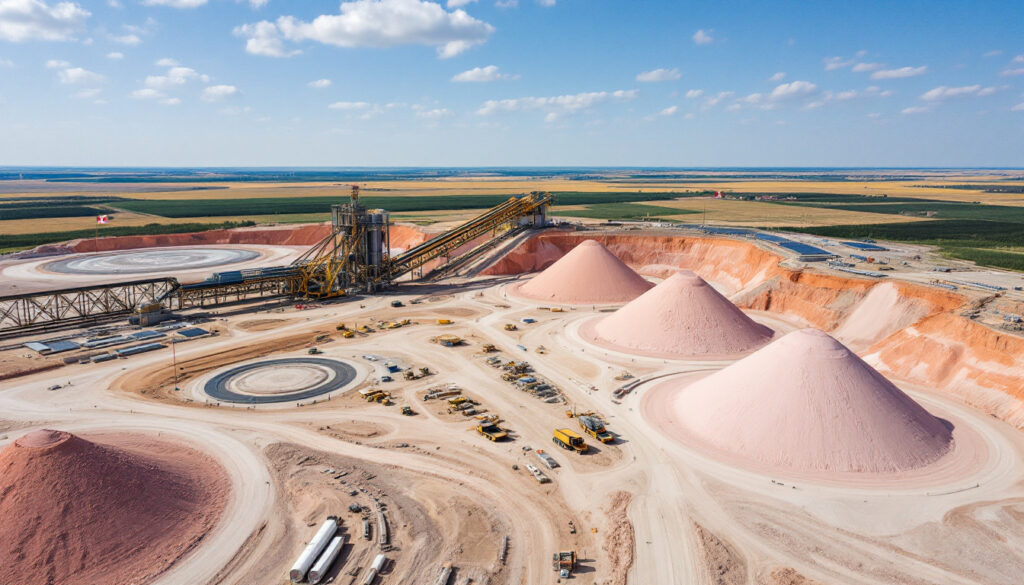BHP's Jansen Potash Mine: A $10 Billion Investment Toward Sustainable Agricultural Futures
BHP's $10 billion Jansen Potash Mine in Saskatchewan represents one of the most significant strategic shifts in modern mining history, combining unprecedented sustainability benchmarks with corporate repositioning in the global commodities market. Designed to produce 4.3 million tonnes of potash annually starting in 2026, the project integrates engineering innovations that achieve 30% greater energy efficiency and 40% superior water conservation compared to existing Saskatchewan operations. While navigating U.S. tariff tensions and market diversification challenges, BHP leverages this investment to transition from steelmaking materials to agricultural commodities, aligning with digital transformation in mining trends and long-term projections for global food security demands.
What is the Jansen Potash Mine?
BHP's Strategic Pivot to "Future-Facing Commodities"
BHP's $10 billion capital allocation to the Jansen project marks a deliberate transition toward commodities supporting decarbonisation in mining and population growth. This strategic investment in Saskatchewan, Canada positions BHP in one of the world's premier potash regions, with access to high-quality resources that align perfectly with future market demands.
The Saskatchewan deposit's geological profile positions it within the Elk Point Basin, containing 53% of global potash reserves. By targeting this region, BHP secures access to high-grade sylvinite ore bodies averaging 28% potassium chloride (KCl), enabling competitive extraction costs against legacy producers in Russia and Belarus.
Saskatchewan's stable regulatory environment contrasts sharply with geopolitical risks in Eastern European potash regions. The province contributes 30% of global potash supply, with existing infrastructure reducing greenfield development risks. BHP's entry diversifies global production away from Belarusian Potash Company (BPC) and Uralkali, whose combined market share exceeds 40%.
Production Timeline and Capacity
The initial phase targets 4.3 million tonnes/year capacity using continuous mining systems with automated haulage networks. This throughput equates to 8% of 2024's global potash trade volume, sufficient to fertilize 12 million hectares of cropland annually. The twin shaft system, sunk to 1,100 meters, enables access to the Patience Lake evaporite formation, with reserves supporting a 70-year mine life at full production.
As one of the largest greenfield potash developments globally, Jansen is currently in an advanced development stage. The project's construction timeline has remained on track despite global supply chain challenges, positioning BHP to begin production next year with full capacity reached by 2026.
How Does Jansen's Sustainability Compare to Other Potash Operations?
Industry-Leading Efficiency Metrics
Jansen's design incorporates closed-loop water systems that recycle 95% of process water, reducing freshwater intake to 0.25 cubic meters per tonne of ore—a 40% improvement over industry averages. Thermal integration systems capture waste heat from compaction equipment, lowering energy consumption by 1.2 PJ/year compared to conventional mines.
Traditional solution mining requires 5.2 GJ/tonne KCl, while Jansen's mechanical evaporation and crystallization processes consume 3.6 GJ/tonne. This efficiency stems from vertical integration with Saskatchewan's renewable grid, where 83% of electricity derives from hydro and wind sources.
The project's direct emissions profile of 0.18 tonnes CO₂e/tonne KCl outperforms the Saskatchewan average of 0.28 tonnes. Electrification of haulage fleets and conveyor systems eliminates 450,000 litres/year of diesel consumption compared to conventional operations.
Environmental Design Innovations
BHP has implemented specialized engineering throughout the Jansen project to minimize its environmental footprint. The mine's water conservation technologies include advanced filtration systems and water recycling processes that significantly reduce freshwater withdrawal from local sources.
Energy efficiency measures extend beyond production facilities to include administrative buildings and transportation systems. The company has invested in high-efficiency motors, variable frequency drives, and regenerative braking systems for its conveyor networks, further reducing energy requirements.
These mining sustainability innovations weren't afterthoughts but foundational design principles from the project's inception. By purpose-building Jansen with environmental considerations from the ground up, BHP has created a mine that not only meets but exceeds their corporate sustainability targets across multiple metrics.
What Market Challenges Will Jansen Face?
Navigating Tariff Tensions
With 25% of global potash shipments facing U.S. Section 301 tariffs, BHP prioritizes customer diversification across Latin America and Southeast Asia. The company's existing iron ore and copper trade networks facilitate cross-selling opportunities, potentially reducing reliance on the U.S. market to below 35% of Jansen's output.
The United States represents a major consumer market for potash, particularly given its extensive agricultural sector. Current trade politics and tariff uncertainties have created a complex landscape for new market entrants like BHP's Jansen operation. However, the company is developing comprehensive strategies to weather these political and trade headwinds through careful market positioning.
Global Market Positioning
BHP's partnerships with CN Rail and Vancouver port authorities ensure transportation costs remain below $40/tonne to Asian markets, undercutting Russian Baltic Sea shipments by $15/tonne. Dedicated unit trains with 12,000-tonne capacity will connect Jansen to export terminals in 72-hour turnaround cycles.
The company is strategically developing international customer relationships across multiple regions to insulate against market-specific disruptions. This approach leverages BHP's extensive global presence and established distribution networks, providing Jansen with significant advantages despite being a new entrant in the potash market.
By reducing dependence on any single market region, BHP's Jansen operation aims to maintain stable production and sales volumes regardless of regional economic or political fluctuations. This diversification strategy represents a key component of the project's risk management approach.
What Makes the Jansen Project Significant for BHP?
Strategic Value to BHP's Portfolio
The mine's Phase 1 output could boost global cereal production by 48 million tonnes/year, addressing the FAO's projected 60% increase in food demand by 2050. Potassium chloride application increases wheat yields by 24% in phosphorus-deficient soils, critical for regions like Sub-Saharan Africa.
Jansen represents a major diversification into the fertilizer sector for BHP, establishing the company as a significant player in agricultural commodities. This move complements BHP's existing portfolio of resources, creating a more balanced exposure across different economic sectors and market cycles.
The strategic pivot aligns with long-term global commodities insights and trends toward food security and agricultural productivity. As climate change and population growth increase pressure on global food systems, fertilizer components like potash become increasingly critical resources with stable demand projections.
Investment Scale and Commitment
By adding 4.3 million tonnes to global supply, Jansen could reduce potash price volatility from historical ±35% annual swings to ±18% post-2026. BHP's cost leadership position at $80/tonne cash costs provides buffer capacity against market downturns.
The $10 billion total investment demonstrates BHP's significant commitment to the potash sector. This represents one of the company's largest current development projects and signals strong confidence in the long-term fundamentals of the potash market despite short-term price fluctuations.
BHP's willingness to make such a substantial capital allocation to Jansen underscores the company's long-term outlook on agricultural resource demand. This investment horizon spans decades rather than years, positioning BHP for sustainable returns throughout market cycles.
FAQ About BHP's Jansen Potash Mine
When will the Jansen potash mine begin production?
BHP is targeting a 2026 production start for the Jansen potash mine, with plans to reach 4.3 million tonnes of production capacity.
How much has BHP invested in the Jansen potash project?
BHP has committed $10 billion to develop the Jansen potash mine in Saskatchewan, Canada.
What sustainability advantages does the Jansen mine offer?
The Jansen mine is designed to be 30% more energy-efficient and 40% more water-efficient than comparable potash operations in Saskatchewan.
How is BHP addressing market challenges for its potash production?
BHP is focusing on diversifying its customer base to mitigate risks associated with tariff tensions and trade uncertainties, particularly regarding the U.S. market.
The Future of Potash Production in Saskatchewan
Regional Economic Impact
The Jansen project will establish itself as a major employer in the Saskatchewan region, creating thousands of direct and indirect jobs throughout construction and operational phases. Local communities will benefit from infrastructure improvements, including road upgrades, power distribution enhancements, and telecommunications expansions.
BHP's presence brings significant technology and skills transfer to the Canadian mining sector. Advanced automation, remote operations capabilities, and sustainability innovations developed at Jansen will likely influence practices throughout Saskatchewan's resource industry, creating a knowledge diffusion effect that extends beyond direct employment.
The economic multiplier effect of Jansen extends to supporting industries from maintenance services to hospitality. BHP's community investment approach typically includes education initiatives, healthcare improvements, and cultural preservation efforts, further enhancing the project's regional impact.
Industry Benchmarks and Standards
BHP's Jansen Potash Mine is poised to set new efficiency standards for potash mining worldwide. The project's innovative approaches to energy management, water conservation, and operational efficiency will likely influence future mine developments globally as companies seek to replicate these sustainability advantages.
The technological innovations deployed at Jansen, including advanced monitoring systems and predictive maintenance protocols, demonstrate the viability of large-scale sustainable potash production. These technologies improve operational performance while simultaneously reducing environmental impacts—a combination that strengthens the business case for sustainable mining practices.
As global agricultural demands increase in coming decades, Jansen's production methods may become industry standards for new developments. The project's ability to balance economic returns with environmental stewardship establishes a benchmark against which future potash operations will be measured, potentially elevating standards across the entire industry and addressing ESG challenges in mining.
Want to Profit from the Next Major Mineral Discovery?
Discovery Alert's proprietary Discovery IQ model delivers instant notifications on significant ASX mineral discoveries, transforming complex data into actionable investment insights. Explore how historic discoveries have generated substantial returns by visiting Discovery Alert's dedicated discoveries page and position yourself ahead of the market.




